CATTI二级笔译实务之汉译英(一)A
- 格式:doc
- 大小:17.50 KB
- 文档页数:1
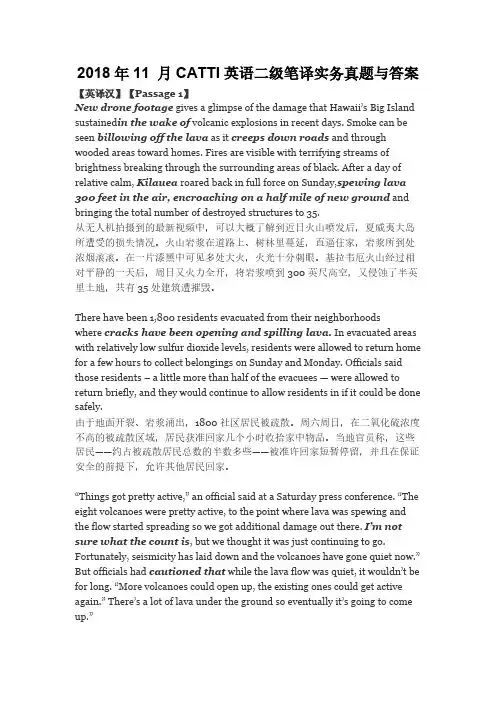
2018年11 月CATTI英语二级笔译实务真题与答案【英译汉】【Passage 1】New drone footage gives a glimpse of the damage that Hawaii’s Big Island sustained in the wake of volcanic explosions in recent days. Smoke can be seen billowing off the lava as it creeps down roads and through wooded areas toward homes. Fires are visible with terrifying streams of brightness breaking through the surrounding areas of black. After a day of relative calm, Kilauea roared back in full force on Sunday,spewing lava 300 feet in the air, encroaching on a half mile of new ground and bringing the total number of destroyed structures to 35.从无人机拍摄到的最新视频中,可以大概了解到近日火山喷发后,夏威夷大岛所遭受的损失情况。
火山岩浆在道路上、树林里蔓延,直逼住家,岩浆所到处浓烟滚滚。
在一片漆黑中可见多处大火,火光十分刺眼。
基拉韦厄火山经过相对平静的一天后,周日又火力全开,将岩浆喷到300英尺高空,又侵蚀了半英里土地,共有35处建筑遭摧毁。
There have been 1,800 residents evacuated from their neighborhoodswhere cracks have been opening and spilling lava. In evacuated areas with relatively low sulfur dioxide levels, residents were allowed to return home for a few hours to collect belongings on Sunday and Monday. Officials said those residents – a little more than half of the evacuees — were allowed to return briefly, and they would continue to allow residents in if it could be done safely.由于地面开裂、岩浆涌出,1800社区居民被疏散。
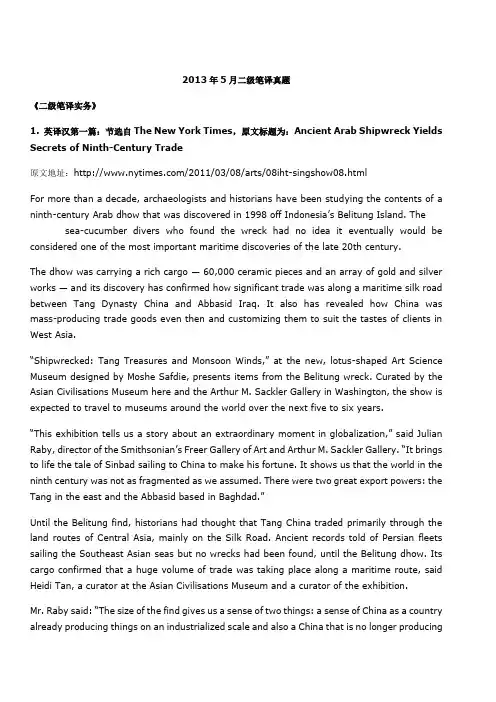
2013年5月二级笔译真题《二级笔译实务》1. 英译汉第一篇:节选自The New York Times,原文标题为:Ancient Arab Shipwreck Yields Secrets of Ninth-Century Trade原文地址:/2011/03/08/arts/08iht-singshow08.htmlFor more than a decade, archaeologists and historians have been studying the contents of a ninth-century Arab dhow that was discovered in 1998 off Indonesia’s Belitung Island. The sea-cucumber divers who found the wreck had no idea it eventually would be considered one of the most important maritime discoveries of the late 20th century.The dhow was carrying a rich cargo — 60,000 ceramic pieces and an array of gold and silver works — and its discovery has confirmed how significant trade was along a maritime silk road between Tang Dynasty China and Abbasid Iraq. It also has revealed how China was mass-producing trade goods even then and customizing them to suit the tastes of clients in West Asia.“Shipwrecked: Tang Treasures and Monsoon Winds,” at the new, lotus-shaped Art Science Museum designed by Moshe Safdie, presents items from the Belitung wreck. Curated by the Asian Civilisations Museum here and the Arthur M. Sackler Gallery in Washington, the show is expected to travel to museums around the world over the next five to six years.“This exhibition tells us a story about an extraordinary moment in globalization,” said Julian Raby, director of the Smithsonian’s Freer Gallery of Art and Arthur M. Sackler Gallery. “It brings to life the tale of Sinbad sailing to China to make his fortune. It shows us that the world in the ninth century was not as fragmented as we assumed. There were two great export powers: the Tang in the east and the Abbasid based in Baghdad.”Until the Belitung find, historians had thought that Tang China traded primarily through the land routes of Central Asia, mainly on the Silk Road. Ancient records told of Persian fleets sailing the Southeast Asian seas but no wrecks had been found, until the Belitung dhow. Its cargo confirmed that a huge volume of trade was taking place along a maritime route, said Heidi Tan, a curator at the Asian Civilisations Museum and a curator of the exhibition.Mr. Raby said: “The size of the find gives us a sense of two things: a sense of China as a country already producing things on an industrialized scale and also a China that is no longer producingceramics to bury.” He was referring to the production of burial pottery like camels and horses, which was banned in the late eighth century. “Instead, kilns looked for other markets and they started producing tableware and they b uilt an export market.”2. 英译汉第二篇:同样节选自The New York Times,原文标题为:E.U. Signals Big Shift on Genetically Modified Crops原文地址:/2010/05/10/business/energy-environment/10green.htmlMadeira is more than 500 kilometers from the African coast and is officially one of the “outermost regions” of the European Union. Despi te that far-flung status, Madeira catapulted into the center of the Union’s agricultural and environmental affairs last year when Portugal asked the European Commission for permission to impose an unprecedented ban on growing biotech crops there.Last week, the commission quietly let the deadline pass for opposing Portugal’s request, allowing Madeira, which is one of Portugal’s autonomous regions, to become the first E.U. territory to get formal permission from Brussels to remain entirely free of genetically modified organisms. Madeira now will probably go ahead and implement the ban, a spokeswoman for the Portuguese government said Friday.Individual European countries and regions have banned certain genetically modified crops before. Many consumers and farmers in countries like Austria, France and Italy regard the crops as potentially dangerous and likely to contaminate organically produced food. But the case of Madeira represents a significant landmark, because it is the first time the commission, which runs the day-to-day affairs of the European Union, has permitted a country to impose such a sweeping and definitive rejection of the technology.The Madeirans’ main concerns focused on preserving the archipelago’s biodiversity and its forest of subtropical laurel trees. Such forests, known as laurisilva, were once widespread on the European mainland but were wiped out thousands of years ago during an earlier period of climate change. That has left Madeira with “much the largest extent of laurel forest surviving in the world, with a unique suite of plants and animals,” according to the United Nations Educational, Scientific and Cultural Organization, which named the Madeiran laurisilva a World Heritage Site in 1999. The forest also is a growing attraction for tourists, who make up a significant portion of Madeira’s earnings.In seeking to ban biotechnology on Madeira, the Portuguese government told the commission that it would be impossible to separate crops containing genetically engineered material fromother plant life. The “risk to nature presented by the deliberate release of GMOs is so dangerous and poses such a threat to the environmental and ecological health of Madeira, that it is not worthwhile risking their use, either directly in the agricultural sector or even on an experimental basis,” the Portuguese told the commission.3. 汉译英第一篇:稀土是不可再生的重要自然资源,在经济社会发展中的用途日益广泛,如光学、电子信息、航空航天、核工业等尖端科技领域。
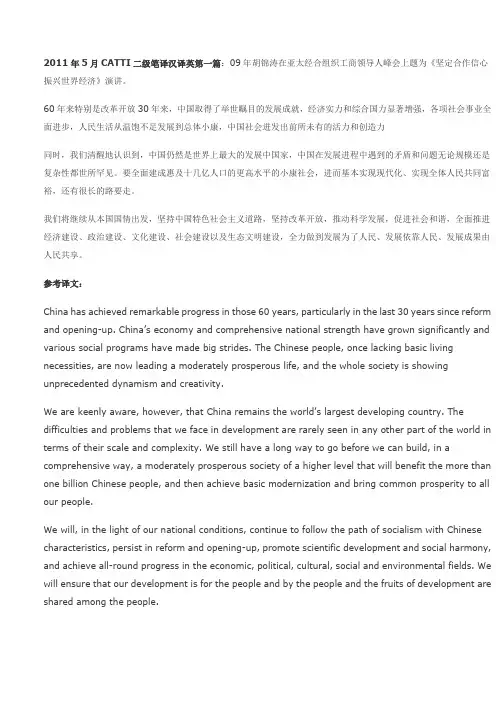
2011年5月CATTI二级笔译汉译英第一篇:09年胡锦涛在亚太经合组织工商领导人峰会上题为《坚定合作信心振兴世界经济》演讲。
60年来特别是改革开放30年来,中国取得了举世瞩目的发展成就,经济实力和综合国力显著增强,各项社会事业全面进步,人民生活从温饱不足发展到总体小康,中国社会迸发出前所未有的活力和创造力同时,我们清醒地认识到,中国仍然是世界上最大的发展中国家,中国在发展进程中遇到的矛盾和问题无论规模还是复杂性都世所罕见。
要全面建成惠及十几亿人口的更高水平的小康社会,进而基本实现现代化、实现全体人民共同富裕,还有很长的路要走。
我们将继续从本国国情出发,坚持中国特色社会主义道路,坚持改革开放,推动科学发展,促进社会和谐,全面推进经济建设、政治建设、文化建设、社会建设以及生态文明建设,全力做到发展为了人民、发展依靠人民、发展成果由人民共享。
参考译文:China has achieved remarkable progress in those 60 years, particularly in the last 30 years since reform and opening-up. China’s economy and comprehensive national strength have grown significantly and various social programs have made big strides. The Chinese people, once lacking basic living necessities, are now leading a moderately prosperous life, and the whole society is showing unprecedented dynamism and creativity.We are keenly aware, however, that China remains the world’s largest developing country. The difficulties and problems that we face in development are rarely seen in any other part of the world in terms of their scale and complexity. We still have a long way to go before we can build, in a comprehensive way, a moderately prosperous society of a higher level that will benefit the more than one billion Chinese people, and then achieve basic modernization and bring co mmon prosperity to all our people.We will, in the light of our national conditions, continue to follow the path of socialism with Chinese characteristics, persist in reform and opening-up, promote scientific development and social harmony, and achieve all-round progress in the economic, political, cultural, social and environmental fields. We will ensure that our development is for the people and by the people and the fruits of development are shared among the people.。
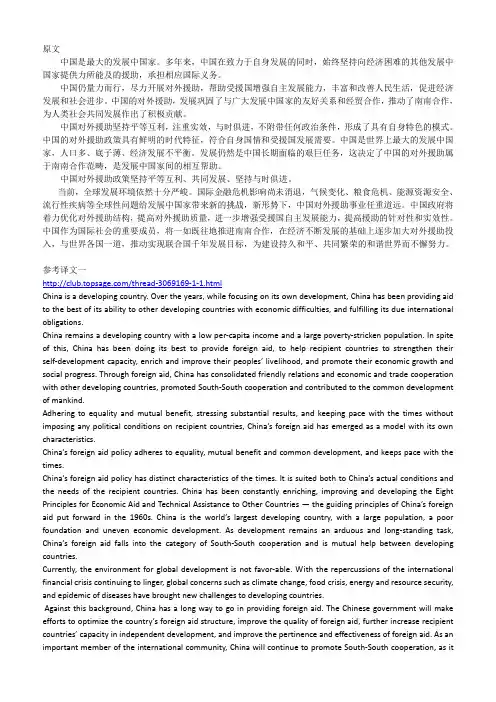
原文中国是最大的发展中国家。
多年来,中国在致力于自身发展的同时,始终坚持向经济困难的其他发展中国家提供力所能及的援助,承担相应国际义务。
中国仍量力而行,尽力开展对外援助,帮助受援国增强自主发展能力,丰富和改善人民生活,促进经济发展和社会进步。
中国的对外援助,发展巩固了与广大发展中国家的友好关系和经贸合作,推动了南南合作,为人类社会共同发展作出了积极贡献。
中国对外援助坚持平等互利,注重实效,与时俱进,不附带任何政治条件,形成了具有自身特色的模式。
中国的对外援助政策具有鲜明的时代特征,符合自身国情和受援国发展需要。
中国是世界上最大的发展中国家,人口多、底子薄、经济发展不平衡。
发展仍然是中国长期面临的艰巨任务,这决定了中国的对外援助属于南南合作范畴,是发展中国家间的相互帮助。
中国对外援助政策坚持平等互利、共同发展、坚持与时俱进。
当前,全球发展环境依然十分严峻。
国际金融危机影响尚未消退,气候变化、粮食危机、能源资源安全、流行性疾病等全球性问题给发展中国家带来新的挑战,新形势下,中国对外援助事业任重道远。
中国政府将着力优化对外援助结构,提高对外援助质量,进一步增强受援国自主发展能力,提高援助的针对性和实效性。
中国作为国际社会的重要成员,将一如既往地推进南南合作,在经济不断发展的基础上逐步加大对外援助投入,与世界各国一道,推动实现联合国千年发展目标,为建设持久和平、共同繁荣的和谐世界而不懈努力。
参考译文一/thread-3069169-1-1.htmlChina is a developing country. Over the years, while focusing on its own development, China has been providing aid to the best of its ability to other developing countries with economic difficulties, and fulfilling its due international obligations.China remains a developing country with a low per-capita income and a large poverty-stricken population. In spite of this, China has been doing its best to provide foreign aid, to help recipient countries to strengthen their self-development capacity, enrich and improve their peoples’ livelihood, and p romote their economic growth and social progress. Through foreign aid, China has consolidated friendly relations and economic and trade cooperation with other developing countries, promoted South-South cooperation and contributed to the common development of mankind.Adhering to equality and mutual benefit, stressing substantial results, and keeping pace with the times without imposing any political conditions on recipient countries, China’s foreign aid has emerged as a model with its own characteristics.C hina’s foreign aid policy adheres to equality, mutual benefit and common development, and keeps pace with the times.China’s foreign aid policy has distinct characteristics of the times. It is suited both to China’s actual conditions and the needs of the recipient countries. China has been constantly enriching, improving and developing the Eight Principles for Economic Aid and Technical Assistance to Other Countries —the guiding principles of China’s foreign aid put forward in the 1960s. China is the world’s largest developing country, with a large population, a poor foundation and uneven economic development. As development remains an arduous and long-standing task, China’s foreign aid falls into the category of South-South cooperation and is mutual help between developing countries.Currently, the environment for global development is not favor-able. With the repercussions of the international financial crisis continuing to linger, global concerns such as climate change, food crisis, energy and resource security, and epidemic of diseases have brought new challenges to developing countries.Against this background, China has a long way to go in providing foreign aid. The Chinese government will make efforts to optimize the country’s foreign aid structure, i mprove the quality of foreign aid, further increase recipient countries’ capacity in independent development, and improve the pertinence and effectiveness of foreign aid. As an important member of the international community, China will continue to promote South-South cooperation, as italways has done, gradually increase its foreign aid input on the basis of the continuous development of its economy, promote the realization of the UN Millennium Development Goals, and make unremitting efforts to build, together with other countries, a prosperous and harmonious world with lasting peace.参考译文二Helen翻译China is the largest developing country. For many years, while China is committed to its own development, all the time it has been persisting in its effort to provide as much aid as it can, meanwhile undertaking corresponding international obligations.According to its own abilities, China also has tried to carry out foreign aid program to help strengthen the independent development ability of recipient countries, to enrich and improve their peoples’ lives, and to promote economic development and social advances in these countries. China’s foreign assistance has developed and consolidated the friendly relationship and economy & trade cooperation with a wide range of developing countries, and prompted the South-South cooperation, which makes active contributes to common development of the whole human society.China’s foreign aid abides by equality and mutual benefits, meanwhile stressing actual effect, progressing with time, and without any political conditions, thus forms a pattern with its own characteristics. China’s foreign aid possesses obvious features of times, conforming to China’s own conditions as well as the needs of countries aided. China is the largest developing country, with a huge population, weak economic foundation, and unbalanced economic development in different regions. Development is still the arduous task facing China in the long run, which determines that the South-South nature of its foreign aid, a kind of help among developing countries.The policy of China’s foreign aid sticks to equality and mutual benefits, mutual development, persisting in progressing with time.Currently, the environment of global development is still very severe, with such global problems as unabated impact of international financial crisis, climate change, food crisis, energy source safety and epidemic diseases posing new challenges to developing countries. Under new circumstances, the course of China’s foreign aid has a far distance to go. Chinese government will focus on optimizing the structure of its foreign assistance, improving its quality, strengthening the independent development of recipient countries, and enhancing the pertinence and efficiency. As an important member within international community, China will promote South-South cooperation, and gradually enlarge foreign-aid input based on its continually economic development. China will also, together with other countries, promote the actualization of UN millenary development target, and make unswerving effort for the construction of a harmonious world with lasting peace and mutual prosperity.。
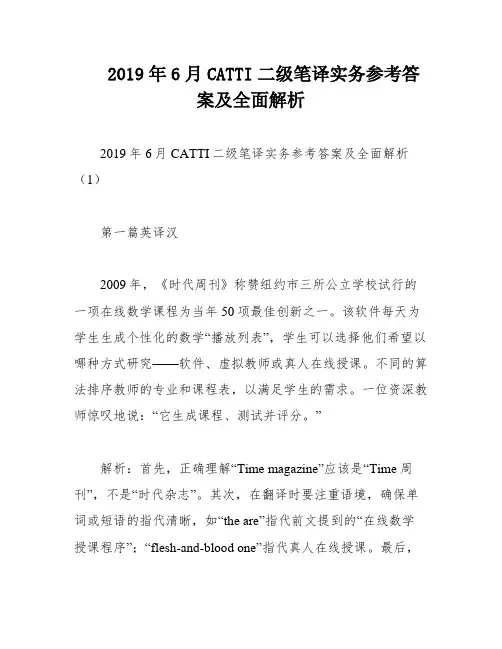
2019年6月CATTI二级笔译实务参考答案及全面解析2019年6月CATTI二级笔译实务参考答案及全面解析(1)第一篇英译汉2009年,《时代周刊》称赞纽约市三所公立学校试行的一项在线数学课程为当年50项最佳创新之一。
该软件每天为学生生成个性化的数学“播放列表”,学生可以选择他们希望以哪种方式研究——软件、虚拟教师或真人在线授课。
不同的算法排序教师的专业和课程表,以满足学生的需求。
一位资深教师惊叹地说:“它生成课程、测试并评分。
”解析:首先,正确理解“Time magazine”应该是“Time周刊”,不是“时代杂志”。
其次,在翻译时要注重语境,确保单词或短语的指代清晰,如“the are”指代前文提到的“在线数学授课程序”;“flesh-and-blood one”指代真人在线授课。
最后,要注意词语的选择,如“different algorithm”可以翻译成“独特算法”,而不是简单的“不同的计算程序”。
在2009年,《时代周刊》发表文章,称赞一种在线数学教育新程序,将其列为当年50大杰出创新成果之一。
该程序已在纽约市的3所公立学校进行试点运行。
该课程软件每日更新授课内容,以满足学生不同的需求,并提供多种播放模式选择,包括软件或虚拟教师授课,以及真人在线教学。
该课程软件采用独特的算法,对教师的专业和排课时间进行分类,以满足每位学生的需求。
一位经验丰富的教师赞叹道,“该软件不仅提供在线课程,还有测试环节,并能对测试内容进行评分。
”原文中没有格式错误或明显有问题的段落)XXX’s future。
The report called for a series ofreforms that XXX school days and years。
morehomework。
higher standards and more testing。
It also called forschools to adopt “computer-based XXX.” This reportset the stage for a new era of school XXX.Andrea Gabor's book。
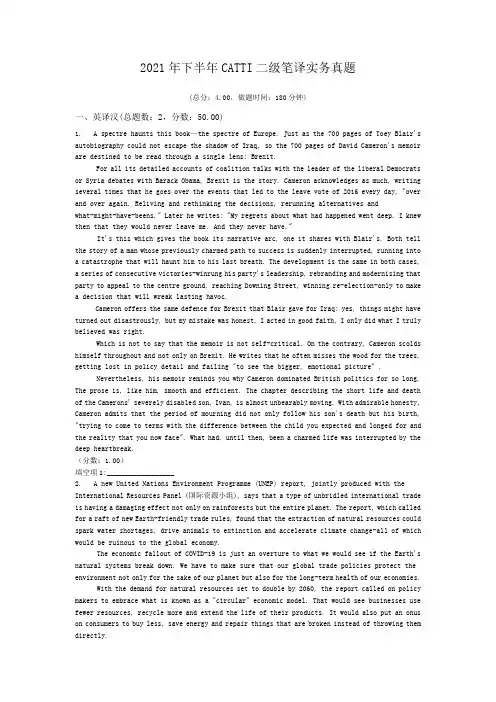
2021年下半年CATTI二级笔译实务真题(总分:4.00,做题时间:180分钟)一、英译汉(总题数:2,分数:50.00)1. A spectre haunts this book—the spectre of Europe. Just as the 700 pages of Toey Blair's autobiography could not escape the shadow of Iraq, so the 700 pages of David Cameron's memoir are destined to be read through a single lens: Brexit.For all its detailed accounts of coalition talks with the leader of the liberal Democrats or Syria debates with Barack Obama, Brexit is the story. Cameron acknowledges as much, writing several times that he goes over the events that led to the leave vote of 2016 every day, "over and over again. Reliving and rethinking the decisions, rerunning alternatives andwhat-might-have-beens." Later he writes: "My regrets about what had happened went deep. I knew then that they would never leave me. And they never have."It's this which gives the book its narrative arc, one it shares with Blair's. Both tell the story of a man whose previously charmed path to success is suddenly interrupted, running into a catastrophe that will haunt him to his last breath. The development is the same in both cases, a series of consecutive victories-winrung his party's leadership, rebranding and modernising that party to appeal to the centre ground, reaching Downing Street, winning re-election-only to make a decision that will wreak lasting havoc.Cameron offers the same defence for Brexit that Blair gave for Iraq: yes, things might have turned out disastrously, but my mistake was honest, I acted in good faith, I only did what I truly believed was right.Which is not to say that the memoir is not self-critical. On the contrary, Cameron scolds himself throughout and not only on Brexit. He writes that he often misses the wood for the trees, getting lost in policy detail and failing "to see the bigger, emotional picture" .Nevertheless, his memoir reminds you why Cameron dominated British politics for so long. The prose is, like him, smooth and efficient. The chapter describing the short life and death of the Camerons' severely disabled son, Ivan, is almost unbearably moving. With admirable honesty, Cameron admits that the period of mourning did not only follow his son's death but his birth, "trying to come to terms with the difference between the child you expected and longed for and the reality that you now face". What had, until then, been a charmed life was interrupted by the deep heartbreak.(分数:1.00)填空项1:__________________2. A new United Nations Environment Programme (UNEP) report, jointly produced with the International Resources Panel (国际资源小组), says that a type of unbridled international trade is having a damaging effect not only on rainforests but the entire planet. The report, which called for a raft of new Earth-friendly trade rules, found that the extraction of natural resources could spark water shortages, drive animals to extinction and accelerate climate change-all of which would be ruinous to the global economy.The economic fallout of COVID-19 is just an overture to what we would see if the Earth's natural systems break down. We have to make sure that our global trade policies protect the environment not only for the sake of our planet but also for the long-term health of our economies.With the demand for natural resources set to double by 2060, the report called on policy makers to embrace what is known as a "circular" economic model. That would see businesses use fewer resources, recycle more and extend the life of their products. It would also put an onus on consumers to buy less, save energy and repair things that are broken instead of throwing them directly.While the circular model could have "economic implications" for countries that depend on natural resources, it would give rise to new industries devoted to recycling and repairing. Overall, the report predicts a greener economic model would boost growth by 8 per cent by 2060. There's this idea out there that we have to log, mine, and drill our way to prosperity. But that's not true. By embracing a circular economy and reusing material, we can still drive economic growth while protecting the planet for future generations.Some countries, both in the developed and developing world, have embraced the concept of a circular economy. But the report said international trade agreements can play an important role in making those systems more common. It called on the World Trade Organization, which has 164 member countries, to take the environment into consideration when setting regulations. It also recommends that regional trade pacts promote investment in planet-friendly industries, eliminate "harmful" subsidies, like those for fossil fuels, and avoid undercutting global environmental accords.Re-orienting the global environment isn't an easy job. There are a lot of vested interests we have to contend with. But with the Earth's population expected to reach almost 10 billion by 2050, we need to find ways to relieve the pressure on the planet.(分数:1.00)填空项1:__________________二、汉译英(总题数:2,分数:50.00)3. 北京市妇女联合会(Beijing Women's Federation)是北京地区各族各界妇女的群众组织,也是中华全国妇女联合会的地方组织。
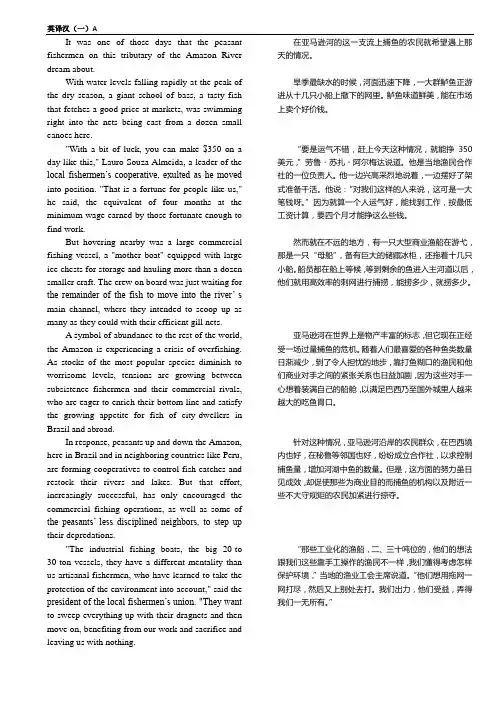
英译汉(一)AIt was one of those days that the peasant fishermen on this tributary of the Amazon River dream about.With water levels falling rapidly at the peak of the dry season, a giant school of bass, a tasty fish that fetches a good price at markets, was swimming right into the nets being cast from a dozen small canoes here."With a bit of luck, you can make $350 on a day like this," Lauro Souza Almeida, a leader of the local fishermen’s cooperative, exulted as he moved into position. "That is a fortune for people like us," he said, the equivalent of four months at the minimum wage earned by those fortunate enough to find work.But hovering nearby was a large commercial fishing vessel, a "mother boat" equipped with large ice chests for storage and hauling more than a dozen smaller craft. The crew on board was just waiting for the remainder of the fish to move into the river’ s main channel, where they intended to scoop up as many as they could with their efficient gill nets.A symbol of abundance to the rest of the world, the Amazon is experiencing a crisis of overfishing. As stocks of the most popular species diminish to worrisome levels, tensions are growing between subsistence fishermen and their commercial rivals, who are eager to enrich their bottom line and satisfy the growing appetite for fish of city-dwellers in Brazil and abroad.In response, peasants up and down the Amazon, here in Brazil and in neighboring countries like Peru, are forming cooperatives to control fish catches and restock their rivers and lakes. But that effort, increasingly successful, has only encouraged the commercial fishing operations, as well as some of the peasants’ less disciplined neighbors, to step up their depredations."The industrial fishing boats, the big 20-to 30-ton vessels, they have a different mentality than us artisanal fishermen, who have learned to take the protection of the environment into account," said the president of the local fishermen’s union. "They want to sweep everything up with their dragnets and then move on, benefiting from our work and sacrifice and leaving us with nothing.在亚马逊河的这一支流上捕鱼的农民就希望遇上那天的情况。
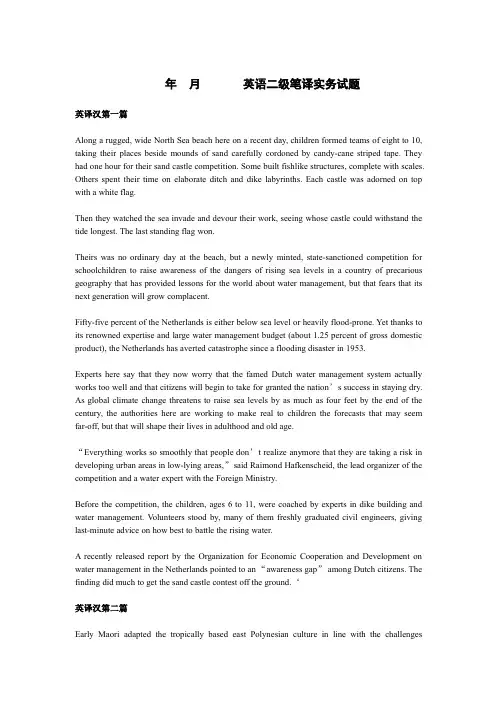
2015年5月CATTI英语二级笔译实务试题英译汉第一篇Along a rugged,wide North Sea beach here on a recent day,children formed teams of eight to10, taking their places beside mounds of sand carefully cordoned by candy-cane striped tape.They had one hour for their sand castle competition.Some built fishlike structures,complete with scales. Others spent their time on elaborate ditch and dike labyrinths.Each castle was adorned on top with a white flag.Then they watched the sea invade and devour their work,seeing whose castle could withstand the tide longest.The last standing flag won.Theirs was no ordinary day at the beach,but a newly minted,state-sanctioned competition for schoolchildren to raise awareness of the dangers of rising sea levels in a country of precarious geography that has provided lessons for the world about water management,but that fears that its next generation will grow complacent.Fifty-five percent of the Netherlands is either below sea level or heavily flood-prone.Yet thanks to its renowned expertise and large water management budget(about1.25percent of gross domestic product),the Netherlands has averted catastrophe since a flooding disaster in1953.Experts here say that they now worry that the famed Dutch water management system actually works too well and that citizens will begin to take for granted the nation’s success in staying dry. As global climate change threatens to raise sea levels by as much as four feet by the end of the century,the authorities here are working to make real to children the forecasts that may seem far-off,but that will shape their lives in adulthood and old age.“Everything works so smoothly that people don’t realize anymore that they are taking a risk in developing urban areas in low-lying areas,”said Raimond Hafkenscheid,the lead organizer of the competition and a water expert with the Foreign Ministry.Before the competition,the children,ages6to11,were coached by experts in dike building and water management.Volunteers stood by,many of them freshly graduated civil engineers,giving last-minute advice on how best to battle the rising water.A recently released report by the Organization for Economic Cooperation and Development on water management in the Netherlands pointed to an“awareness gap”among Dutch citizens.The finding did much to get the sand castle contest off the ground.‘英译汉第二篇Early Maori adapted the tropically based east Polynesian culture in line with the challengesassociated with a larger and more diverse environment,eventually developing their own distinctive culture.Even though the majority of the population now lives in cities,much of New Zealand’s art, literature,film and humor has rural themes.The British and Irish immigrants brought aspects of their own culture to New Zealand and also influenced Maori culture.More recently American,Australian,Asian and other European cultures have exerted influence on New Zealand.New Zealand music has been influenced by blues,jazz,country,rock and roll and hip hop,with many of these genres given a unique New Zealand interpretation.Māori developed traditional chants and songs from their ancient South-East Asian origins,and after centuries of isolation created a unique“monotonous”and“doleful”sound.Our vision recognises that our distinctive culture is core to what makes New Zealand a great place to live.Cultural expression,engagement and understanding are fundamental to a vibrant and healthy society and help define what it is to be a New Zealander.Māori culture makes New Zealand unique in a globalised world and is central to our sense of place,identifying us as a nation.Active participation by Māori in distinct te ao Māori activity,will ensure Māori culture is protected and flourishes.ManatūTaonga/the Ministry for Culture and Heritage(the Ministry)is the Government’s leading advisor on cultural matters;funds,monitors and supports a range of cultural agencies;and delivers a range of high quality cultural products and services.The Ministry provides advice to the Government on where to focus its interventions in the cultural sector.The Ministry seeks to ensure that Vote funding is invested as effectively and efficiently as possible,and that the Government’s priorities are met.The Ministry has a strong track record of delivering high quality publications(including websites), managing our significant heritage and commemorations,and acting as guardian of New Zealand’s culture and kaitiaki of New Zealand’s taonga.Our work prioritises cultural outcomes and supports educational,economic,and social outcomes linking with the work of a range of other government agencies.汉译英第一篇改革开放30多年来,西藏通过深化改革和扩大开放积极推动全区商业、对外贸易和旅游产业加快发展,不仅增强了与内地的交流,同时也加强了与世界的联系和合作。
![20120529catti二级笔译中译英第1篇真题及参考谜底[最新]](https://uimg.taocdn.com/45a89e55a9956bec0975f46527d3240c8447a138.webp)
20110529CATTI二级笔译中译英第1篇真题及参考答案和平稳定是发展的前提和基础。
上个世纪,人类经历了两次世界大战,生灵涂炭,经济社会发展遭受严重挫折。
第二次世界大战结束以来,世界经济能够快速增长,主要得益于相对和平稳定的国际环境。
参考译文一:Peace and stability are the precondition and foundation for development. Last century, human society underwent twice worldwide wars, which deprived lots of lives, and greatly hindered the development of economy and society. Since the end of the World War II, the rapid growth of global economy has been mainly attributed to the relatively peaceful and stable international environment.参考译文二:Peace and stability form the prerequisite and foundation for development. The two world wars in the last century caused mankind untold sufferings and world economic and social development severe setbacks. It is mainly due to the relatively peaceful and stable international environment that the world economy has been able to grow at a fast pace in the post-war era. The World Bank statistics show that none of the countries persistently under violent conflict has achieved the UN Millennium Development Goals (MDGs). To maintain world peace and stability so that the people can live a happy and prosperous life is the primary responsibility for governments and leaders of all countries.我们应该恪守联合国宪章宗旨和原则,充分发挥联合国及其安理会在维护和平、缔造和平、建设和平方面的核心作用。
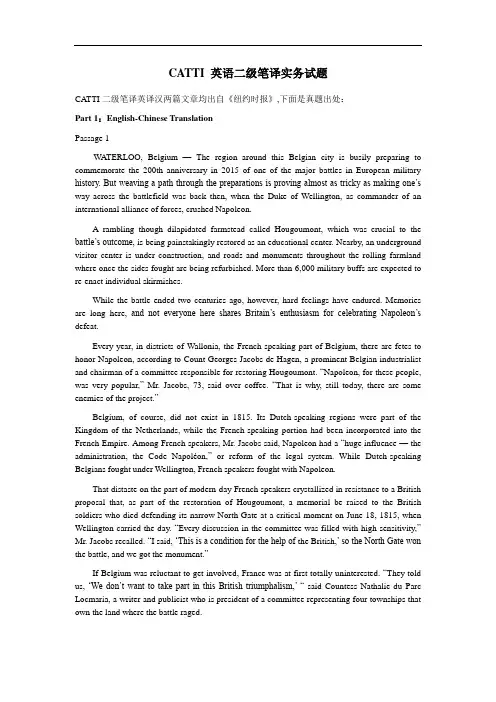
CATTI 英语二级笔译实务试题CA TTI二级笔译英译汉两篇文章均出自《纽约时报》,下面是真题出处:Part 1:English-Chinese TranslationPassage 1WATERLOO, Belgium —The region around this Belgian city is busily preparing to commemorate the 200th anniversary in 2015 of one of the major battles in European military history. But weaving a path through the preparations is proving almost as tricky as making one’s way across the battlefield was back then, when the Duke of Wellington, as commander of an international alliance of forces, crushed Napoleon.A rambling though dilapidated farmstead called Hougoumont, which was crucial to the battle’s outcome, is being painstakingly restored as an educational center. Nearby, an underground visitor center is under construction, and roads and monuments throughout the rolling farmland where once the sides fought are being refurbished. More than 6,000 military buffs are expected to re-enact individual skirmishes.While the battle ended two centuries ago, however, hard feelings have endured. Memories are long here, and not everyone here shares Britain’s enthusiasm for celebrating Napoleon’s defeat.Every year, in districts of Wallonia, the French-speaking part of Belgium, there are fetes to honor Napoleon, according to Count Georges Jacobs de Hagen, a prominent Belgian industrialist and chairman of a committee responsible for restoring Hougoumont. “Napoleon, for these people, was very popular,”Mr. Jacobs, 73, said over coffee. “That is why, still today, there are some enemies of the project.”Belgium, of course, did not exist in 1815. Its Dutch-speaking regions were part of the Kingdom of the Netherlands, while the French-speaking portion had been incorporated into the French Empire. Among French speakers, Mr. Jacobs said, Napoleon had a “huge influence — the administration, the Code Napoléon,”or reform of the legal system. While Dutch-speaking Belgians fought under Wellington, French speakers fought with Napoleon.That distaste on the part of modern-day French speakers crystallized in resistance to a British proposal that, as part of the restoration of Hougoumont, a memorial be raised to the British soldiers who died defending its narrow North Gate at a critical moment on June 18, 1815, when Wellington carried the day. “Every discussion in the committee was filled with high sensitivity,”Mr. Jacobs recalled. “I said, ‘This is a condition for the help of the British,’ so the North Gate won the battle, and we got the monument.”If Belgium was reluctant to get involved, France was at first totally uninterested. “They told us, ‘We don’t want to take part in this British triumphalism,’ “said Countess Nathalie du Parc Locmaria, a writer and publicist who is president of a committee representing four townships that own the land where the battle raged.(原文地址:http:///2013/09/2 ... )Passage 2Bayer cares about the bees.Or at least that’s what they tell you at the company’s Bee Care Center on its sprawling campus here between Düsseldorf and Cologne. Outside the cozy two-story building that houses the center is a whimsical yellow sculpture of a bee. Inside, the same image is fashioned into paper clips, or printed on napkins and mugs.”Bayer is strictly committed to bee health,” said Gillian Mansfield, an official specializing in strategic messaging at the company’s Bayer CropScience division. She was sitting at the center’s semicircular coffee bar, which has a formidable espresso maker and, if you ask, homegrown Bayer honey. On the surrounding walls, bee fun facts are written in English, like “A bee can fly at roughly 16 miles an hour” or, it takes “nectar from some two million flowers in order to produce a pound of honey.” Next year, Bayer will open another Bee Care Center in Raleigh, N.C., and has not ruled out more in other parts of the world.There is, of course, a slight caveat to all this buzzy good will.Bayer is one of the major producers of a type of pesticide that the European Union has linked to the large-scale die-offs of honey bee populations in North America and Western Europe. They are known as neonicotinoids, a relatively new nicotine-derived class of pesticide. The pesticide wasbanned this year for use on many flowering crops in Europe that attract honey bees.Bayer and two competitors, Syngenta and BASF, have disagreed vociferously with the ban, and are fighting in the European courts to overturn it.Hans Muilerman, a chemicals expert at Pesticide Action Network Europe, an environmental group, accused Bayer of doing “almost anything that helps their products remaining on the market. Massive lobbying, hiring P.R. firms to frame and spin, inviting commissioners to show their plants and their sustainability.””Since they learned people care about bees, they are happy to start the type of actions you mention, ‘bee care centers’ and such,” he said.There is a bad guy lurking at the Bee Care Center — a killer of bees, if you will. It’s just not a pesticide.Bayer’s culprit in the mysterious mass deaths of bees can be found around the corner from the coffee bar. Looming next to another sculpture of a bee is a sculpture of a parasite known as a varroa mite, which resembles a gargantuan cooked crab with spiky hair.The varroa, sometimes called the vampire mite, appears to be chasing the bee next to it, which already has a smaller mite stuck to it. And in case the message was not clear, images of the mites, which are actually quite small flash on a screen at the center.While others point at pesticides, Bayer has funded research that blames mites for the beedie-off. And the center combines resources from two of the company’s divisions, Bayer CropScience and Bayer Animal Health, to further study the mite menace.”The varroa is the biggest threat we have”said Manuel Tritschler, 28, a third-generation beekeeper who works for Bayer. “It’s very easy see to them, the mites, on the bees,”he said, holding a test tube with dead mites suspended in liquid. “They suck the bee blood, from the adults and from the larvae, and in this way they transport a lot of different pathogens, virus, bacteria, fungus to the bees,” he said.Conveniently, Bayer markets products to kill the mites too — one is called CheckMite — and Mr. Tritschler’s work at the center included helping design a “gate”to affix to hives that coats bees with such chemical compounds.There is no disputing that varroa mites are a problem, but Mr. Muilerman said they could not be seen as the only threat.The varroa mite “cannot explain the massive die-off on its own,” he said. “We think the bee die-off is a result of exposure to multiple stressors.”(原文地址:http:///2013/12/1 ... )汉译英第一篇矿产资源是自然资源的重要组成部分,是人类社会发展的重要物质基础。

2021年下半年CATTI英语二级笔译实务真题及局部答案下面是二级笔译考题回忆,一起来看看。
英译汉第一篇You’ve temporarily misplaced your cell phone and anxiously retrace your steps to try to find it. Or perhaps you never let go of your phone—it's always in your hand, your pocket, or your bag, ready to be answered or consulted at a moment’s notice. When your battery life runs down at the end of the day, you feel that yours is running low as well. New research shows that there’s a psychological reason for such extreme phone dependence: According to the attachment theory, for some of us, our phone serves the same function as the teddy bear we clung to in childhood.Attachment theory proposes that our early life experiences with parents responsible for our well-being, are at the root of our connections to the adults with whom we form close relationships. Importantly, attachment in early life can extend to inanimate objects. Teddy bears, for example, serve as“transitional objects.〞The teddy bear, unlike the parent, is always there. We extend our dependence onparents to these animals, and use them to help us move to an independent sense of self.A cell phone has the potential to be a “compensatory attachment〞object. Although phones are often castigated for their addictive potential, scientists cite evidence that supports the idea that “healthy, normal adults also report significant emotional attachment to special objects〞Indeed, cell phones have become a pervasive feature of our lives: The number of cell phone users exceeds the total population of the planet. The average amount of mobile or smartphone use in the U.S. is 3.3 hours per day.People also like to be near their phones: A 2021 survey cited by the Hungarian team. Nearly as many people report being distressed when they’re separated from their phone.Phones have distinct advantages. They can be kept by your side and they provide a social connection to the people you care about. Even if you’re not talking to your friends, lover, or family, you can keep their photos close by, read their messages, and follow them on social media. You can track them in real time but also look back on memorable moments together. These channels help you “feel less alone〞.来源:英译汉第二篇〔reference 〕Many countries have adopted the principle of sustainable development it can combat gaginst environment deterioration in air quality, water quality and ...viable role for every member in the world..production .health education in developing countries. But some argue that it's a vague idea, some organizations may use it in it's own interests, whether environmental or economic is the nature of interests. Others argue that sustainable development in developing countries overlook the local customs,habitude and people.Whereas interdependence is desirable during times of peace, war necessitates competition and independence. Tariffs and importation limits strengthen a country's economic vitality while potentially weakening the economies of its enemies. Moreover, protectionism in the weapons industry is highly desirable during such circumstances because reliance on another state for armaments can be fatal.For the most part, economists emphasize the negative effects of protectionism. It reduces international trade and raises prices for consumers. In addition, domestic firms that receive protection have less incentive to innovate. Although free trade puts uncompetitive firms out of business, the displaced workers and resources are ultimately allocated to other areas of the economy.Imposing quotas is a method used to protect trade, since foreign companies cannot ship more products regardless of how low they set their prices. Countries that hope to help a new industry thrive locally often impose quotas on imported goods. They believe that such restrictions allow entities in the new industry to develop their own competitive advantages and produce the products efficiently. Developing countries often use this argument to justify their restrictions on foreign goods.Protectionism’s purpose is usually to create jobs for domestic workers. Companies that operate in industries protected by quotas hire workers locally. Another disadvantage of quotas is the reduction in the quality of products in the absence of competition from foreign companies. Without competition, local firms are less likely to invest in innovation and improve their products and services. Domestic sellers don’t have an incentive to enhance efficiency and lower their prices, and under such conditions, consumers eventually pay morefor products and services they could receive from foreign competitors. As local companies lose competitiveness, they become pressured to outsource jobs. In the long-run, increasing protectionism commonly leads to layoffs and economic slowdown.汉译英第一篇〔中国的中医药?白皮书〕人类在漫长开展进程中创造了丰富多彩的世界文明,中华文明是世界文明多样性、多元化的重要组成局部。
2019年6月CATTI二级笔译实务参考答案及全面解析(1)第一篇英译汉In 2009, Time magazine hailed an online math program piloted at three New York City public schools, as one of the year’s 50 best innovations. Each day, the software generated individualized math “playlists” for students who then chose the “modality” in which they wished to learn — software, a virtual teacher or a flesh-and-blood one. A different algorithm sorted teachers’ specialties and schedules to match a student’s needs. “It generates the lessons, the tests and it grades the tests,” one veteran instructor marveled.解析:不是《时代杂志》,而是《时代周刊》。
原文的理解不是停留在表层,而是深入理解原文的意义、内涵、句法结构和逻辑思路。
具体体现在某些单词的指代要清晰,词语选择要到位。
the software generated individualized math “playlists” for students who then chose the “modality” in which they wished to learn 在这里看到the software前面的the就要知道指代前文提到的在线数学授课程序。
2020.11 CATTI英语二级笔译实务试题英译汉参考译文仅供参考English-Chinese TranslationTranslate the following two passages into English.【Passage 1】The world is at a social, environmental and economic tipping point. Subdued growth, rising inequalities and accelerating climate change provide the context for a backlash against capitalism, globalization, technology, and elites. There is gridlock in the international governance system and escalating trade and geopolitical tensions are fueling uncertainty. This holds back investment and increases the risk of supply shocks: disruptions to global supply chains, sudden price spikes or interruptions in the availability of key resources.Persistent weaknesses in the drivers of productivity growth are among the principal culprits. In advanced, emerging and developing economies, productivity growth started slowing in 2000 and decelerated further after the crisis. Between 2011 and 2016, “total factor productivity growth” – or the combined growth of inputs, like resources and labour, and outputs - grew by 0.3 percent in advanced economies and 1.3 percent in emerging and developing economies.The financial crisis added to this deceleration. Investments are undermined by uncertainty, low demand and tighter credit conditions. Many of the structural reforms designed to revive productivity that were promised by policy-makers did not materialize.Governments must better anticipate the unintended consequences of technological integration and implement complementary social policies that support populations through the Fourth Industrial Revolution. Economies with strong innovation capability must improve their talent base and the functioning of their labor markets.Adaption is critical. We need an a well-functioning labour market that protects workers, not jobs. Advanced economies need to develop their skills base and tackle rigidities in their labour markets. As innovation capacity grows, emerging economies need to strengthen their skills and labour market to minimize the risks of negative social spillovers.Sustainable economic growth remains the surest route out of poverty and a core driver of human development. For the past decade, growth has been weak and remains below potential in most developing countries, seriously hampering progress on several of the UN’s 2030 sustainable development Goals (SDGs).The world is not on track to meet any of the SDGS. Least developed countries have missed the target of 7 percent growth every year since 2015. Extreme poverty reduction is decelerating. 3.4 billion people –or 46 percent of the world’s population – lived on less than US$5.50 a day and struggled to meet basic needs. After years of steady decline, hunger has increased and now affects 826 million up from 784 million in 2015. A total of 20 percent of Africans population is undernourished. The “zero hunger” target will almost certainly be missed.参考译文世界正处在社会、环境和经济的转折点。
汉译英(一)A
众所周知,鸟无翅膀不能飞,人无双腿不能走。
但对尹小星而言,鸟无翅膀不能飞,人无双腿却能走!
1970年出生于江苏一户农民家庭的尹小星,出生仅8个月就患小儿麻痹症并发急性肺炎。
虽然最终保住了命,他却再也不能站立。
因为身体残疾,初中毕业后小星不得不辍学。
生存的压力对他来说显得格外沉重,他贩过水果,养过鸡,还下工夫学习过中医。
在他21岁的时候,这个年轻人竞怀揣一幅地图,手持一个指南针,摇着轮椅踏上了走遍全中国的艰难路途。
近12年来小星手摇轮椅,足迹遍布31个省、市、自治区,行程7万多公里,用坏了4部轮椅。
他实现了徒手攀登泰山、华山、衡山等20多座名山,孤身翻越海拔5231米的唐古拉山,手摇轮椅走过丝绸之路,穿越塔克拉玛干(Taklimakan)大沙漠,徒手攀登上海东方明珠电视塔,圆满完成从沙漠到香港的旅行。
As everyone knows, birds cannot fly without wings and a person cannot walk without legs. But for Yin Xiaoxing, while birds cannot fly without wings, a person can walk even without legs !
Born in 1970 into a farmer’s family in Jiangsu Province, Yin Xiaoxing suffered from polio and acute pneumonia at the age of only eight months. He survived but lost the ability to stand on his feet. Because of his disability, Xiaoxing had to give up his study after junior middle school. The burden of life seemed to be especially heavy for him. He tried to make a living by selling fruits, raising chickens and taking pains to learn traditional Chinese medicine.
At the age of 21, this young man, with a map and a compass in hand, embarked on the hard journey of traveling around China in his wheelchair.
In the last 12 years, Yin Xiaoxing traveled a total of 70,000 kilometers in his wheelchair and left his footprints in 31 provinces, municipalities and autonomous regions. During this period, he wore out four wheelchairs. He left a trail of human records including climbing more than 20 famous mountains like Mount Tai, Mount Hua and Mount Heng with his hands, crossing the 5,231-meter-high Mount Tanggula alone, traveling along the Silk Road in wheelchair, crossing the Taklimakan Desert, getting to the top of the Oriental Pearl TV tower in Shanghai with his hands, and completing the journey from the desert to Hong Kong.。